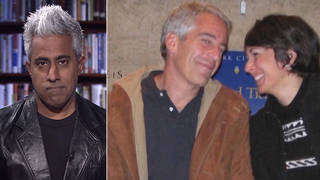
The Supreme Court ruled a Ten Commandments monument could remain on the grounds of the Texas State Capitol but that framed wall displays in two Kentucky courthouses violated the First Amendment because officials put them there for religious reasons. [includes rush transcript]
The Supreme Court delivered a split verdict on displays of the Ten Commandments yesterday. The court ruled a decades-old monument could remain on the grounds of the Texas State Capitol but that framed wall displays in two Kentucky courthouses violated the First Amendment because officials put them there for religious reasons. Both votes were 5-4 rulings involving shifting majorities, producing a total of 10 opinions.
- Rev. Barry Lynn, attorney and ordained minister. He is the executive director of Americans United for Separation of Church and State in Washington, D.C.
Transcript
AMY GOODMAN: We’re joined by Reverend Barry Lynn, an attorney and ordained minister. He’s Executive Director of Americans United for Separation of Church and State. He is based in Washington, D.C. Welcome, Barry Lynn.
REV. BARRY LYNN: Thank you. Very nice to be here.
AMY GOODMAN: We don’t have much time, but can you give your response to these what are being called the split rulings on church and state?
REV. BARRY LYNN: Sure, absolutely. In a nutshell, what this means is that as a practical matter, those old Ten Commandments monuments that date from around 1960-1961 when the movie with Charlton Heston as Moses called The Ten Commandments was being played. It was being promoted in part by movie companies, giving these Ten Commandments monuments very similar to the one that was upheld in Texas yesterday. If you have those old monuments sitting in front of your city council building, particularly if they are surrounded by a bunch of other secular markers and monuments, you’ve probably got, sadly, because I don’t agree with the result, but sadly, you would have a Constitutional display, at least in the minds of five Justices.
However, if you are trying to set up, as religious right groups are doing, announcing today that they’re going to put new Ten Commandments monuments up around the country and try to force this to become a bigger political issue at the local level, I think those efforts will be Constitutionally fruitless, because I think the reading of the court yesterday was that new promotion of the Ten Commandments motivated by religion, and that’s clearly the motivation of people like the Family Research Council, Judge Roy Moore down in Alabama and others, that those new monuments will not stand up as Constitutional under yesterday’s decisions.
AMY GOODMAN: And the way the Court divided on these issues?
REV. BARRY LYNN: Well, it was kind of strange, because Justice Breyer, who is kind of a moderate to progressive vote, in general, voted to uphold the Texas — the old Texas monument. Basically said, 'Look, no one has complained about it for over 40 years.' He kind of said there’s a grandfathered-in sense about those monuments. If people haven’t been complaining about them from day one, then they must not be that much of a problem in the community, and that was, I think a thin reed on which to justify the placement of what is by most accounts, and I think most listeners would agree, the Ten Commandments are a religious statement.
Most of them do not even have a parallel in the civil law of this country. We don’t have laws against coveting your neighbor’s S.U.V. or Prius or anything in between; if we did, we would have hundreds of thousands of people in a federal penitentiary. We don’t have blasphemy laws. Very few states even have laws against adultery. We don’t make Sabbath worship or failing to worship on some Sabbath a crime.
So, our Constitution and our secular laws are not based on the Ten Commandments. The Ten Commandments were not used by the framers of the Constitution in creating the secular democracy that we have. And frankly, had Justice Breyer simply admitted that this was religious, it didn’t matter that it was there 40 years, if someone complains about it now, that’s enough. We would have seen a complete victory, and a clean line established. The line government buildings should not be mistaken for churches. They should not be decorated like churches. Unfortunately, we didn’t get there.
AMY GOODMAN: Well, on that note, I want to thank you very much for being with us, Barry Lynn of Americans United for Separation of Church and State.












Media Options